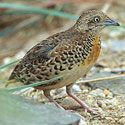|
Family: Turnicidae (buttonquails)
Life > Eukaryotes > Opisthokonta > Metazoa (animals) > Bilateria > Deuterostomia > Chordata > Craniata > Vertebrata (vertebrates) > Gnathostomata (jawed vertebrates) > Teleostomi (teleost fish) > Osteichthyes (bony fish) > Class: Sarcopterygii (lobe-finned fish) > Stegocephalia (terrestrial vertebrates) > Tetrapoda (four-legged vertebrates) > Reptiliomorpha > Amniota > Reptilia (reptiles) > Romeriida > Diapsida > Archosauromorpha > Archosauria > Dinosauria (dinosaurs) > Saurischia > Theropoda (bipedal predatory dinosaurs) > Coelurosauria > Maniraptora > Aves (birds) > Order: Turniciformes
Species indigenous to southern Africa
|
Turnix
hottentottus (Hottentot buttonquail, Black-rumped buttonquail) |
|
|
Turnix
nanus (Black-rumped buttonquail) |
|
|
Turnix
sylvaticus (Kurrichane buttonquail) The
Kurrichane buttonquail occurs across Africa south of Sahel, as well is in
Asia in Europe, living mainly in grasslands. It eats a mixed diet of insects
and seeds, especially of grasses. It is polyandrous, nesting in a scrape in
the ground lined with grass. It lays 2-4 eggs, incubated solely by the male,
for about 12-15 days (recorded in captivity). They chicks leave the nest
within hours of hatching, taking their first flight at about 10 days old,
and are fully grown at about 35 days old. |
 |
|
